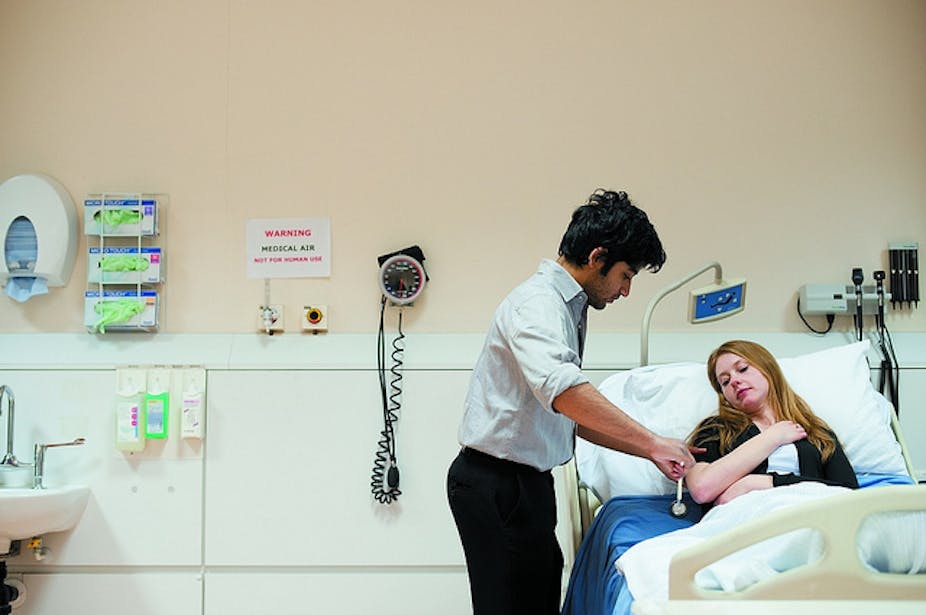Amid Australia’s ongoing doctor shortage, the health system risks losing dozens of Australian-trained, foreign-born doctors because of a shortage of intern places. The Australian Medical Students Association estimates the system needs 182 intern places to ensure all international students can finish their medical training and gain full registration as doctors.
These intern, (or post-graduate year one) places, are based in hospitals, which are run by the states. But the Commonwealth also bears some funding responsibility for medical training. The Commonwealth, state and territory health ministers are expected to discuss who should pay and potential solutions to the problem when they meet tomorrow in Perth.
Rise of international student migration
Over the past decade, international students have emerged as a prized and contested human capital resource. OECD and select Asian countries are expanding their international student flows, through global promotion strategies and regional migration programs, aligned with lower entry requirements, including for medical degrees.
International students have been immensely responsive to these migration options. In 1975, 600,000 international students were enrolled abroad, compared with 3.4 million in 2009. By 2025, it is predicted there will be 7.2 million international students studying globally.
A recent British Council survey of 153,000 international students confirmed opportunities for migration exert an extraordinary impact on the choice of study destination. While students sought a high quality, internationally recognised education, the scope to remain and work was found to “massively impact” both decisions and expectations.
In 1999, following the removal of a three-year eligibility bar, international students became immediately eligible to migrate to Australia. Within six years of the policy change, 52% of skilled migrants were selected onshore.

By 2010, 630,000 international students were enrolled in Australian courses (all fields and sectors). Of these, 18,487 were undertaking health degrees, including over 3,000 medical and 10,000 nursing students. International medical student graduates grew 223% from 1999 to 2009, compared with 52% growth in Australian domestic graduates.
International medical students
In 2009, the majority of international medical students were enrolled at Monash, Melbourne, Queensland, New South Wales and Sydney universities. Their source countries were highly diverse – most notably Malaysia (1,134 students), Singapore (577), Canada (437), the United States (84) and Botswana (74), followed by South Korea, Brunei, Hong Kong, Indonesia and Sri Lanka.
These international students achieve stellar rates of immediate employment and are highly attractive to local employers. As demonstrated by yet-to-be-published research conducted for the Medical Deans of Australia, 45% of international students plan to remain in Australia when they commence their studies. By their final year, 78% accept intern places (virtually all those who are not scholarship students sponsored by their home governments).
Australia’s Graduate Destination Survey from 2009-2011 reveals their employment outcomes to be near identical to those achieved by domestic students (99.6% working full-time at four months compared with 99.7%). The source country was almost irrelevant, with 100% of Canadian, US, Malaysian, Indonesian, Taiwanese, Norwegian and Botswanan students fully employed, compared with 97% from Singapore and 89% from China.
International medical graduates
As affirmed by the OECD, Australia has developed extraordinary reliance on international medical graduates (IMGs), who gain their qualifications overseas.
By 2006, 45% of Australian residents holding medical qualifications were overseas-born, including an estimated 25% who were overseas-qualified. The United Kingdom/Ireland, China, India, North Africa/ Middle East, Sri Lanka, Bangladesh, South Africa and the Philippines were major sources of migration.
This diversification of supply has proven extremely challenging for Australia. The 2006 census shows just 53% of IMGs secured medical employment in Australia in their first five years of residence (across all immigration categories).
Doctors from English-speaking background countries moved seamlessly into work, while Commonwealth-Asian doctors fared reasonably. Outcomes were poor, by contrast, for many birthplace groups. Just 6% of doctors from China found medical employment within five years, along with 23% from Vietnam and 31% from Eastern Europe.

Employment access is significantly better for IMGs selected through the 457 visa temporary sponsored pathway. From 2005-06 to 2010-11 17,910 doctors were sponsored as temporary 457 visa migrants to pre-arranged jobs, with a 99% immediate employment rate.
From 2004-05 to 2010-11, an additional 2,790 IMGs were admitted through the permanent General Skilled Migration category. But not all passed the Australian Medical Council examinations, which are a requirement for unconditional registration in Australia. From 1978 to 2010, 82% of candidates passed the MCQ (the standard theoretical examination), typically on their first or second attempt, along with 85% of clinical candidates. But overall AMC completion rates were just 43%, since many choose not to persist with the process.
Large numbers of IMGs face significant barriers to securing professional registration. By contrast, international medical students face no impediments: they’re of prime workforce age (far younger than IMGs) and have self-funded to meet Australian domestic requirements.
Medical students’ future
We know that large numbers of international medical students wish to migrate to Australia – and access to intern places is critical for them to secure permanent resident status.
If Australia fails to retain these graduates, other countries will. Singapore, for instance, actively recruits in Australia, in a context where the nation’s fertility rate is incredibly low. New Zealand annually registers over 1,200 IMGs per year, but two-thirds will have left within two years. So there is major interest in attracting Australian-trained graduates.
If Australia is serious about retaining international medical students in the future, it’s vital to provide access to intern training places. While the students’ long-term intentions are unknown, it’s clear they have great potential to address Australian workforce shortages in the future.

